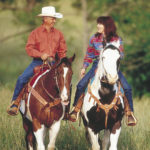Heatstroke – What to Watch For:

Weakness/ staggering; reluctance to move; collapse. Resting heart rate that’s over 60 BPM. Resting respiration rate that’s over 40 breaths per minute. Your horse may pant in a doglike manner; his respiration rate will fail to return to normal, even after an adequate period of rest. Dark red or purplish gum color. Rectal temperature over 104 degrees Fahrenheit, which remains elevated even after rest.
Heatstroke – What’s Happening:
Your horse isn’t able to rid his body of excess heat generated by working muscles. Normally, several mechanisms, including sweat evaporation, help the body cool itself. But extremely hot/humid weather renders these mechanisms helpless. Therefore, blood flow is redistributed close to the body surface to aid in cooling, resulting in a lack of oxygen to internal organs (including the brain). Also, excessive sweating results in fluid and electrolyte losses that can alter your horse’s metabolism. Severe heat stress can lead to collapse, seizures or death.
Heatstroke – What to do:
- Step 1: Immediately dismount, and move your horse out of the direct sun.
- Step 2: Use any available water supply to sponge off your horse. (Tip: A T-shirt makes a handy ‘sponge.’) Hold the wet cloth/shirt against his jugular veins, located in the grooves in the lower part of his neck (and anywhere else you see large vessels through the skin.) Doing so will cool the blood circulating through your horse’s body.
- Step 3: Offer him water. If he’s sweating excessively and willing to drink, administer a dose of electrolytes from your first-aid kit.
- Step 4: Monitor your horse’s vital signs. Continue sponging your horse until these signs return to normal. (Normal vital signs are: heart rate 30 to 40 BPM; respiration rate 12 to 16 BPM; temperature less than 102.5 F.)
- Step 5: Lead your horse home. Stop every 15 minutes and take your horse’s vital sign; rest if he shows any signs of distress. (Tip: If you have a long, tough trail to traverse home, wait until early evening, when the temperature cools down, to tackle it.)
Heatstroke – Risk Factors:
Above-average work demands. High ‘heat index,’ which is environmental temperature added to the percent humidity. The more humid and hot a day is, the higher the heat index. A heat index over 125 means heat stress is a risk.
Heatstroke – Preventative Measures:
Condition your horse for the trail. (Consult with your vet for a conditioning program designed for your horse’s current fitness level and your trail-riding goals.) Monitor the heat index. If it’s over 125, avoid rugged/steep terrain, and trails that offer no shade; monitor your horse’s vital signs every 15 minutes, stopping at the first sign of distress. If it’s over 170, cancel your ride. On hot days, allow your horse to rest every half hour; offer him water at least every 2 to 3 hours.
Click here for more articles on Trail Riding First Aid.
Barb Crabbe, DVM, is a contributing editor at Horse & Rider. She is an Oregon-based equine practitioner.
This article first appeared in Horse & Rider magazine.





